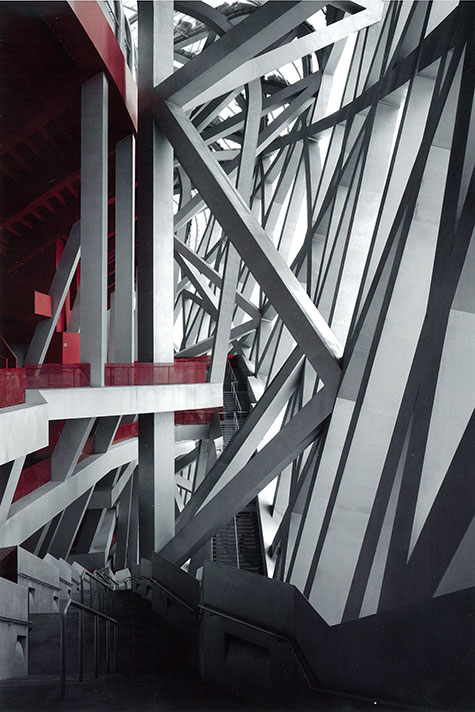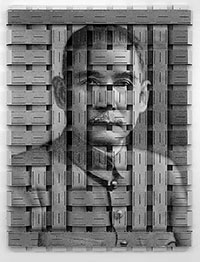
In Beijing (2010), German photographer Andreas Gursky depicts China’s famous “Bird’s Nest” stadium, a spectacular structure designed for the 2008 Olympics by Swiss architects Jacques Herzog and Pierre de Meuron, with Chinese artist and activist Ai Weiwei. Yet to create the image, Gursky digitally combined multiple viewpoints, emphasizing the building’s complex beam structure but also distorting the viewer’s perspective and freeing the final work from its reference to the actual building.
In May, the Mildred Lane Kemper Art Museum will feature Beijing in Contemporary German Art: Selections From the Permanent Collection, an exhibition that highlights 16 large-scale works, all completed within the last 12 years by artists living and working in Germany. The exhibition complements the opening of a major expansion to the Saint Louis Art Museum, which will showcase its own holdings of postwar German art.

In addition to Gursky’s Beijing, Contemporary German Art will feature several important new acquisitions, including Sun Yat-sen (Sign for Moon) (2005) by Thomas Bayrle. Also on view will be works by Franz Ackermann, Thomas Demand, Charline von Heyl, Sergej Jensen and Corinne Wasmuht — all recently acquired thanks to a gift from the James M. Kemper Jr. and the David Woods Kemper Memorial Foundation. Rounding out the exhibition will be major pieces from Cosima von Bonin, Isa Genzken, Ulrike Kuschel, Michel Majerus, Manfred Pernice and Wolfgang Tillmans.
Though all of these artists work within the context of a reunified democratic Germany, none overtly dwell on German history or national identity — nor do they demonstrate a shared visual style or singular medium, as did the so-called German neo-Expressionists in the 1980s. Rather, these artists strongly underscore their own artistic voices and individual concerns. Their artworks, similarities notwithstanding, are principally borne out of difference.
Some, such as Ackermann and the late Majerus, expand the medium of painting into the realm of installation art, endowing it with a monumental presence and stability that reflects but also stands in counterpoint to the global digital revolution. Others, such as Wasmuht, revise the postmodernist strategy of appropriation to create entirely new image worlds — worlds that emphasize slowness in both their conception and perception.
Just as the medium of painting is turned upside down and inside out, so too is the practice of photography. Tillmans, for example, creates large-scale photographs without the use of a camera, while Demand’s practice of documenting temporary sculptures results in photographs that lack a real-world referent. Bayrle — a major figure within postwar German art, who nevertheless remains overlooked internationally — bridges photography, printmaking and sculpture. In Sun Yat-sen, he silkscreens an iconic portrait of the Chinese revolutionary onto a three-dimensional relief of wood and cardboard that suggests both highway structures and collectivist networks.
Other artists explore the incorporation of the everyday into the realm of art. While Pernice challenges the ready-made as impromptu memorial, Genzken’s use of bits and pieces of the materials of daily life bestows otherwise anonymous sculptures with individuality. Von Bonin and Jensen both create objects made out of commonplace textiles, though their approaches differ: Jensen reworks the legacy of collage and found object artists such as Kurt Schwitters, while von Bonin provocatively employs stitching, dark humor and hermetic meaning to further complicate boundaries between popular culture and so-called high art.
Contemporary German Art is curated by Sabine Eckmann, William T. Kemper Director and chief curator. It will open with a public reception from 7 to 9 p.m. Friday, May 3, and remain on view through Sept. 7, 2013. Both the reception and the exhibition are free and open to the public.
The Kemper Art Museum is located on Washington University’s Danforth Campus, immediately adjacent to Steinberg Hall, near the intersection of Skinker and Forsyth boulevards. Regular hours are 11 a.m. to 6 p.m. Mondays, Wednesdays and Thursdays; 11 a.m. to 8 p.m. Fridays; and 11 a.m. to 6 p.m. Saturdays and Sundays. The museum is closed Tuesdays.
Support for Contemporary German Art: Selections From the Permanent Collection is provided by James M. Kemper Jr.; the David Woods Kemper Memorial Foundation; the William T. Kemper Foundation; and members of the Mildred Lane Kemper Art Museum.
For more information, call (314) 935-4523 or visit kemperartmuseum.wustl.edu.